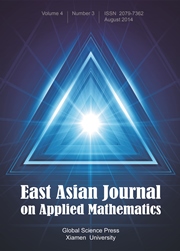Article contents
H1 Stability and Convergence of the FE, FV and FD Methods for an Elliptic Equation
Published online by Cambridge University Press: 28 May 2015
Abstract
We obtain the coefficient matrices of the finite element (FE), finite volume (FV) and finite difference (FD) methods based on P1-conforming elements on a quasi-uniform mesh, in order to approximately solve a boundary value problem involving the elliptic Poisson equation. The three methods are shown to possess the same H1-stability and convergence. Some numerical tests are made, to compare the numerical results from the three methods and to review our theoretical results.
Keywords
- Type
- Research Article
- Information
- Copyright
- Copyright © Global-Science Press 2013
References
[1]Bank, R.E., Rose, D.J., Some error estimates for the box method, SIAM J. Numer. Anal. 24, 777–787 (1987).CrossRefGoogle Scholar
[2]Ben-Artzi, M., Croisille, J. P. and Fishelov, D., Convergence of a compact scheme for the pure streamfunction formulation of the unsteady Navier-Stokes equations, SIAM J. Numer. Anal. 44, 1997–2024 (2006).CrossRefGoogle Scholar
[3]Cai, Z., On the finite volume element method, Numer. Math. 58, 713–735 (1991).CrossRefGoogle Scholar
[4]Chen, L., A new class of high order finite volume methods for second order elliptic equations, SIAM J. Numer. Anal. 47, 4021–4043 (2010).CrossRefGoogle Scholar
[5]Ciarlet, P. G., The Finite Element Method for Elliptic Problems. North-Holland, Amsterdam, 1978.Google Scholar
[6]Ewing, R.E., Lin, T., Lin, Y., On the accuracy of the finite volume element method based on piecewise linear polynomials, SIAM J. Numer. Anal. 39, 1865–1888 (2002).Google Scholar
[7]Hackbusch, W., On first and second order box methods, Computing 41, 277–296 (1989).CrossRefGoogle Scholar
[8]Li, R., Chen, Z., Wu, W., Generalized difference methods for differential equations—Numerical analysis of finite volume methods. Marcel Dekker, Inc, 2000.CrossRefGoogle Scholar
[9]Ma, Y., Mei, L., Wang, A., Modern Numerical Methods for Partial Differential Equations. Science Press, Beijing, 2006.Google Scholar
[10]Rannacher, R., Scott, R., Some optimal error estimates for piecewise linear finite element approximation, Math. Comp. 38, 437–445 (1982).CrossRefGoogle Scholar
[11]Süli, E., Convergence of finite volume schemes for Poisson's equation on nonuniform meshes, SIAM J. Numer. Anal. 28, 1419–1430 (1991).Google Scholar
[12]Thomas, J.W., Numerical Partial Differential Equations – Finite Difference Methods. Springer-Verlag New York, Inc, 1998.Google Scholar
[13]Thomas, J.W., Numerical Partial Differential Equations – Conservation Laws and Elliptic Equations. Springer-Verlag New York, Inc, 1999.CrossRefGoogle Scholar
[14]Saad, Y., Iterative Methods for Sparse Linear Systems, 2nd edition. SIAM, 2003.CrossRefGoogle Scholar
[15]Xu, J., Two-grid discretisation techniques for linear and nonlinear PDEs, SIAM J. Numer. Anal. 33, 1759–1777 (1996).CrossRefGoogle Scholar
[16]Xu, J., Zou, Q., Analysis of linear and quadratic simplicial finite volume methods for elliptic equations, Numer. Math. 111, 469–492 (2009).CrossRefGoogle Scholar
[17]Vanselow, R., Relations between FEM and FVM applied to the Poisson equation, Computing 57, 93–104 (1996).Google Scholar
[18]Mattiussi, C., An analysis of finite volume, finite element, and finite difference methods using some concepts from algebraic topology, J. Comput. Phys. 133, 289–309 (1997).CrossRefGoogle Scholar
- 13
- Cited by


